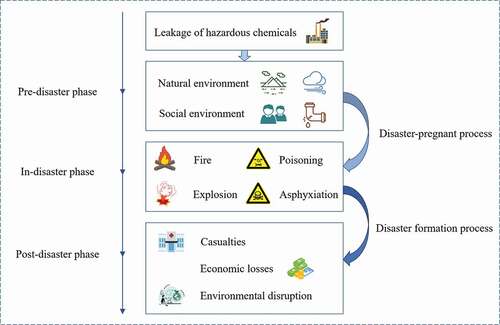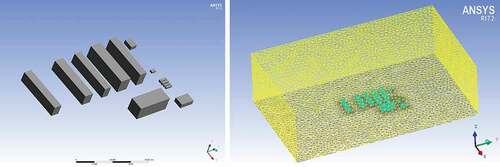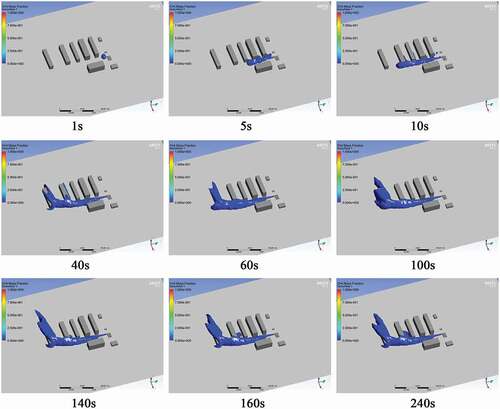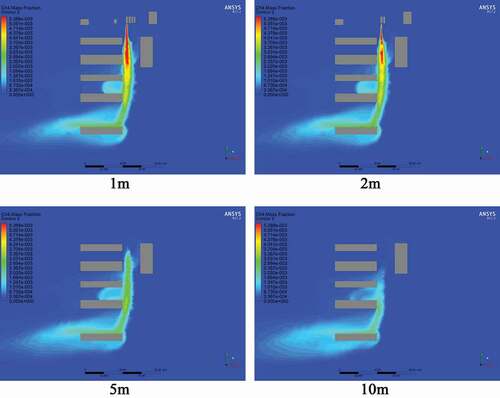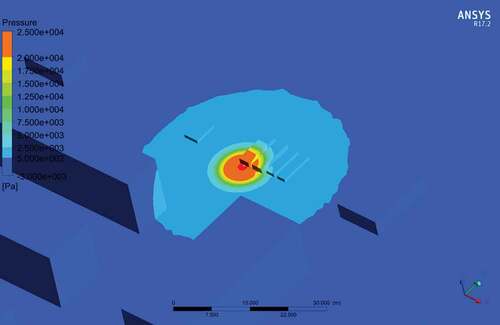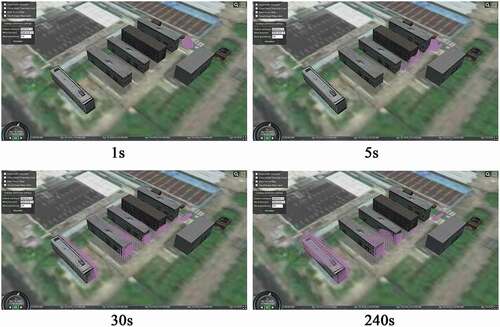 ?Mathematical formulae have been encoded as MathML and are displayed in this HTML version using MathJax in order to improve their display. Uncheck the box to turn MathJax off. This feature requires Javascript. Click on a formula to zoom.
?Mathematical formulae have been encoded as MathML and are displayed in this HTML version using MathJax in order to improve their display. Uncheck the box to turn MathJax off. This feature requires Javascript. Click on a formula to zoom.ABSTRACT
Hazardous chemicals are indispensable substances for the development of modern industries. However, improper storage, transportation, or handling of hazardous chemicals can cause chain disasters such as leakage and explosion, seriously threatening the safety of people’s lives, society, economy, and natural environment. In this study, we analysed the occurrence and evolution process of various disaster events caused by hazardous chemical leakage based on the disaster system theory, and constructed a hazardous chemical leakage disaster chain from the aspects of disaster-causing factors, disaster-pregnant environment, hazard-affected bodies, and post-disaster losses. Taking a methane leakage accident as a case study, we conducted numerical simulation and spatio-temporal dynamic derivation on the hazardous chemical leakage disaster chain in a three-dimensional (3-D) geographic scene. This study can provide support on handling hazardous chemical leakage disasters and assist informed decision-making, including monitoring, pre-warning, disaster forecast and prevention, emergency preparedness, and post-disaster response, further improving the efficiency of emergency response and urban safety management.
1. Introduction
With the rapid development of modern industrialisation, chemical industry not only brings social and economic benefits but also causes frequent disasters due to improper storage, transportation, or handling of hazardous chemicals, threatening people’s lives, society, economy, and ecological system (Wang et al. Citation2018a). Besides, with the improvement of the manufacturing efficiency and scale of various chemical enterprises, hazardous chemicals are generally stored in a centralised and large-scale manner, resulting in the spatial proximity of each major hazard source. Once a disaster event occurs, the surrounding hazard sources can easily form a domino effect, causing a series of disaster events. The disaster can spread from a local area to a larger area and form a more serious disaster chain of hazardous chemicals. For example, in 1984, a liquid petroleum gas (LPG) pipe storage at San Juan Ixhuatepec in Mexico City leaked for nearly 10 minutes. The vapour cloud exploded when it caught fire and caused a series of explosions in the surrounding storage tanks, resulting in about 6000 injuries and more than 500 deaths (Xie Citation2015). In 2015, explosions rocked a warehouse containing hazardous goods in Tianjin Port, resulting in 165 deaths and 798 injuries. Hazardous chemicals spilled out and led to severe water and air pollution. Buildings within 150 metres were also destroyed, with a direct economic loss of 6.866 billion RMB (Zhao Citation2016).
Mastering the evolution mechanism and disaster chain effects caused by hazardous chemical leakage can help emergency managers to be more prepared before disasters and more resilient after disaster events. Presently, research on disaster chains is still in its infancy. Researchers from different fields use different methods and have varying views and interpretations on disaster chains. Guo and Qin (Citation1987) defined a disaster chain as a phenomenon that a series of disasters occurring one after another. Dombrowsky (Citation1995) indicated that natural disaster events are the results of internal physical interaction and will constantly evolve and spread, causing huge losses to human society. Menoni (Citation2001) proposed the concept of loss chain, which is an innovation to the concept of coupled hazardous event damages. Helbing (Citation2013) pointed out that there is a strong causal relationship between disaster events, which makes the disaster system particularly complex. The research on disaster chain has been greatly promoted by expounding its concepts and formation mechanisms. Existing methods for disaster chain research primarily include probability analysis, geospatial analysis based on remote sensing images, and disaster evolution analysis based on complex network theory (Ha et al. Citation2016). Wang et al. (Citation2013) assessed earthquake disaster chains with Bayesian Networks (BNs) method and compared it with commonly used methods, including empirical models, mathematical models, rule-based expert systems, and neural networks, to demonstrate the effectiveness of BNs in expressing disaster mechanism and other aspects. Xu et al. (Citation2012) constructed an ecological disaster chain for the China Wenchuan earthquake using satellite imageries and topographic maps, and studied the formation characteristics of typical earthquake disasters. Buzna et al. (Citation2006) analysed disaster network evolution using complex networks theory, established an applicable disaster dynamic model, and studied the transmission and development process of disasters. Zheng et al. (Citation2019) used the co-word analysis method to extract disaster-related keywords and build a complex disaster network which contains almost all disaster types. However, existing research on disaster chains mainly focuses on the evolution of natural disasters and geological disasters such as earthquakes, landslides, rainstorms, etc. The disaster chains of accidental disasters, such as chemical leakage, fire, explosion, etc., were seldom researched.
Considering the serious physical and health consequences of hazardous chemical leakage, it is essential to study the diffusion process of hazardous chemical for post-disaster evacuation and rescue. The progress of numerical simulation of leaked hazardous chemicals diffusion has greatly improved the quantitative assessment technology of hazardous chemical safety research. Computational Fluid Dynamics (CFD) is a commonly used fluid dynamics numerical analysis model. It can provide accurate predictions on the distributions of concentration field, temperature field, and flow field in the material diffusion process by following basic conservation equations (Wang Citation2014, Chen et al. Citation2018). In recent years, CFD simulation methods have been widely used in hazardous chemical leakage and explosion research. However, researchers tend to regard hazardous chemical disasters as independent research entities, and seldom analyse the coupling relationship among various disasters. Moreover, data fusion visualisation of hazardous chemical disaster scenarios and disaster analysis results can provide more information for emergency rescue decision-making. The GIS technology can efficiently visualise multi-source spatio-temporal data and has been widely used in urban construction and planning, meteorology and hydrology, natural ecological environment, and other fields (Widener et al. Citation2017, Othman et al. Citation2020, Javanbakht et al. Citation2021). Therefore, we posit that it is necessary to leverage GIS technology to investigate the spatio-temporal dynamic derivation of hazardous chemical leakage disasters.
In this paper, we construct a hazardous chemical leakage disaster chain to analyse the occurrence, development, and interactions of various disaster events from the aspects of disaster-causing factors, disaster-pregnant environment, hazard-affected bodies, and post-disaster losses. Then, taking a methane leakage as an example, we perform numerical simulation analysis on the hazardous chemical leakage disaster chain and deduced the evolution process of the disaster chain in a 3-D geographic scene. The remainder of this paper is organised as follows. Section 2 describes the construction of the hazardous chemical leakage disaster chain. Section 3 shows a methane leakage case study and demonstrates the numerical simulation and spatio-temporal derivation of the hazardous chemical leakage disaster chain. Section 4 provides conclusions and opportunities for future work in this area.
2. The construction of hazardous chemical disaster chain
2.1. Mathematical representation of disaster chain
Existing disaster theories indicate that a disaster event is a structural system composed of disaster-causing factors, disaster-pregnant environment, and hazard-affected bodies (Shi Citation2005). A disaster chain is the result of interactions among a disaster event and its surrounding disaster-pregnant environment and other disaster-causing factors. Chen (Citation2017) defines the disaster chain as ‘after the occurrence of a disaster event, within a certain range of time and space, the disaster-pregnant environment acts on the disaster-causing factors in the disaster system and causes them to change and generate new disaster-causing factors, which will further act on the hazard-affected bodies in the system. When the hazard-affected bodies reach a certain critical value, they will lead to new disaster events, and then evolve into a series of disaster events.’ Liu et al. (Citation2006) proposed the mathematical representation of the disaster chain as follows:
Where represents a disaster chain system consisting of
disaster events
, and their internal relations.
represents the disaster event in the system.
represents the correlation between different disaster events.
is the environment of the disaster chain.
The triggering relationship among disaster events in the disaster chain has a time effect, which means the impacts between two disasters can be instantaneous or continuous (Wang and Lv Citation2016). The relationship between two disaster events at the moment t can be characterised as follows:
Where represents disaster event i at time
,
represents the disaster event j at time t, and
represents the relationship between them at time
.
2.2. Disaster mechanism of hazardous chemical disaster chain
Li and Chen (Citation2020) summarised 5169 hazardous chemical accidents that occurred in China from 2013 to 2019, including leakages, explosions, poisonings, asphyxiations, and fires. It was found that the most frequently occurred hazardous chemical accidents are leakages (48.1%), followed by explosions (24.47%). Explosions inflicted the highest casualties, followed by poisonings. In general, chemical explosions are easily caused by an accidental leakage of combustibles when exposed to an ignition source. The blast wave can cause serious deaths and injuries over a short period of time, resulting in destructive impacts.
In this section, we analysed the disaster mechanism of explosion accidents caused by hazardous chemical leakage and establish a hazardous chemical leakage disaster chain model. The disaster mechanism of hazardous chemical leakage is shown in (), which contains three phases (pre-disaster, in-disaster phase, and post-disaster) and two processes (disaster-pregnant process and disaster formation process).
The evolution mechanism of the hazardous chemical leakage disaster chain is a comprehensive embodiment of the spatial effects, temporal effects, and coupling effects. Considering the spatial effects, compared with natural disasters, the affected area of hazardous chemical leakage is relatively small, often within a few hundreds of metres to a few kilometres around the disaster source. People and buildings in different locations suffer different levels of damage. Regarding the temporal effects, a disaster accident includes three phases: pre-disaster, in-disaster, and post-disaster. In the pre-disaster phase, the leaked hazardous chemicals spread and agglomerate under the combined effects of natural and social environments. The disaster-causing factors such as fires, poisonings, or explosions may appear or not yet in this phase. In the in-disaster phase, the disaster-causing factors are exposed and affect hazard-affected bodies. For instance, fire disaster-causing factors can cause high-temperature, thermal radiation, burning, and asphyxiation. Explosion disaster-causing factors can cause explosion fragments splashing and blast wave damage. Poisoning and asphyxiation factors can cause damage to people and animals. And the post-disaster phase reflects the post-disaster losses, including casualties, economic losses, and destruction of social and natural environments. In terms of the coupling effects, the coupling of different objects in the disaster system leads to the occurrence of disasters. In the disaster-pregnant process, the coupling of social and natural environments provides conditions for disaster incubation. In the disaster formation process, the interactions of fire and explosion disaster-causing factors cause the chain effect of disaster accidents. Besides, the coupling of society, economy, and environment results in multi-level and multi-dimensional disaster consequences.
2.3. Analysis and construction of the leakage disaster chain
A hazardous chemical leakage disaster chain is a series of secondary and derivative disasters caused by the leakage of hazardous chemical. After the leakage, the hazard-affected bodies are exposed to and affected by disaster-causing factors. When the instability level of hazard-affected bodies exceeds their thresholds, a series of system environment changes will be induced, leading to the formation of a disaster chain.
Based on the disaster system theory and existing research on the coupling mechanism of leakage disasters (Wang and Lv Citation2016, Yang et al. Citation2017, Li et al. Citation2019), we analysed the disaster-causing factors, disaster-pregnant environment, hazard-affected bodies, and post-disaster losses of the hazardous chemical leakage disaster chain from the perspective of disaster system and consequences.
Disaster-causing factors
The combustibles leakage process is a turbulent jet process in which the leaked material exchanges mass and momentum with surrounding air (Yang et al. Citation2017). Many factors can cause hazardous chemical leakage in the chemical factory, including corrosion of storage tanks and other equipment, improper operation and maintenance, design defects, human activities, and environmental instability. In general, the factors can be classified into four categories, people, equipment, environment, and management. Hazardous chemicals may leak when storage tanks, pipelines, or manufacturing equipment break under the action of internal and external forces. The leaked chemicals mix with a large quantity of air and form a gas cloud. When the concentration of chemicals reaches a certain level, it causes asphyxiation and poisoning disasters. Once the gas cloud is ignited, it leads to a fire disaster when the thermal radiation range exceeds the tolerance limits of people and buildings. When the chemical concentration reaches the explosive limit, the gas cloud is detonated immediately when being exposed to an ignition source, resulting in an explosion accident. The combustible explosions will cause devastating damage to people and buildings, including blast waves, explosive fragments, noise, vibration, and thermal radiation.
Disaster-pregnant environment
The disaster-pregnant environment of hazardous chemical leakage and explosion disasters can be categorised as natural environment and social environment. The natural environment includes topography, landforms, vegetation, soil, hydrology, climate, and meteorological conditions. Among them, meteorological factors such as wind speed, wind direction, atmospheric pressure, and ambient temperature may affect the diffusion distribution of combustibles. The social environment includes chemical enterprises, pipeline and storage facilities, transportation systems, and human activities. The manufacturing, transportation, and storage management of hazardous chemicals are important factors of combustibles leakage, such as fire operation in manufacturing, short-circuit of wires and cables, etc. The damages to chemical transportation systems caused by explosions can expand the scope of disaster as well.
Hazard-affected bodies
The reactions between hazardous chemicals can have serious or even catastrophic consequences if they are not properly handled and managed. The chemical factory includes buildings, warehouse infrastructure, and other types of hazard-affected bodies. The primary hazard-affected bodies of society are people. The leakage or explosion disasters cause injuries and deaths to people and affect the role of people in the disaster situation, who may increase or reduce the impact of disasters with rescue effort. In the economic aspect, leakage and explosion disasters destroy the manufacturing facilities including economic workplaces, material resources, and labourers, resulting in serious economic losses to chemical enterprises due to suspended operations. The environmental hazard-affected bodies include air, water, vegetation, and soil. The leaked toxic chemicals and byproducts derived from fires or explosions will result in lasting contamination and damage to the surrounding vegetation, air, and water.
Post-disaster losses
The losses caused by chemical leakage and explosion can be grouped into three categories: direct economic losses, indirect economic losses, social and environmental losses. The direct economic losses include casualties, property losses, building damages, and traffic interruption. The indirect economic losses include the losses caused by manufacturing suspension and the cost of environmental pollution control. The social and environmental losses include social panic, environmental pollution (water, soil, and air), and destruction of lifeline systems.
To sum up, under the influence of a disaster-pregnant environment and the synergy of various factors, a disaster chain of hazardous chemical leakage occurs when hazard-affected bodies are exposed to disaster-causing factors such as leakage, fire, or explosion, and results in a series of losses in the end. Based on the characteristics and risk analysis of hazardous chemical leakage events, we proposed a hazardous chemical leakage disaster chain as shown in ().
3. Case study
In this section, we chose a methane leakage accident in a chemical factory as a case study to numerically simulate the leakage diffusion and explosion process of the hazardous chemical leakage disaster chain and conduct dynamic spatio-temporal derivation on the simulation results in a 3-D scene.
3.1. Software tools
ANSYS software
Computational fluid dynamics is a numerical calculation method that uses computer technology to simulate the changes of various physical quantities in the fluid flow process and analyse related phenomena such as flow or heat transfer (Wang X. Citation2018b). ANSYS software performs numerical simulation analysis based on the CFD method. It can accurately simulate the diffusion process of materials in the atmosphere, as well as the dynamic changes of basic physical quantities such as velocity, pressure, and others in 3-D space. Besides, it can simulate the leakage process in different environments by changing the boundary conditions. ANSYS software contains three primary components: pre-processing module, calculation module, and post-processing module. The pre-processing module includes the ANSYS Workbench modelling software and the ICEM-CFD meshing software. The calculation module uses Fluent software. And the post-processing module displays the calculation results in graphical forms such as contour lines or surfaces. The leakage and diffusion of flammable substances in 3-D space is a complex transient turbulent behaviour. Fluent uses Reynolds Averaged Navier-Stokes (RANS) to simulate the basic fluid flow, including Spalart-Allmaras model, k-ε model, and other models, and solve the turbulent motion by indirect numerical simulation method (Tauseef et al. Citation2011).
The realisable k-ε model is used to simulate the turbulent movement of gas, the transport equations of the realisable k-ε model are:
Where and
represent the generation of tubulence kinetic energy due to the mean velocity gradients and buoyancy;
and
represent the turbulent Prandtl numbers for k and ε, respectively.
and
are the user defined source terms.
The eddy dissipation model is used to modelling the interaction between vapour cloud explosion and turbulence, in which the net reaction rate of component
in the chemical reaction
takes the minimum value of the following expressions:
Where represents the mass fraction of the reactant
.
is the mass fraction of the product
.
represents the molecular weight of the component
.
and
are the Magnussen constants(Lyu et al. Citation2017).
Caesium platform
Caesium is an open-source 3-D map framework based on Web JavaScript. It provides powerful 3-D visualisation functions for geospatial data, including spatio-temporal dynamic data. To dynamically visualise the gas concentration, pressure, velocity, and other results from ANSYS Fluent simulation in Caesium, we used Esri ArcGIS to convert data from Fluent ASCII format to Caesium supported data formats, including assigning geospatial coordinate system and data format conversion.
3.2. Modelling and simulation analysis
3.2.1. Modelling and meshing
In this section, ANSYS Workbench was used to model the chemical factory. To reduce the meshing difficulty and computational complexity, buildings and chemical tanks with complex structure were simplified into more regular shapes. The chemical factory used in this study is 160 m long, 98 m wide and 15 m high. Then, to discretise the governing equations, the 3-D geometric model of the chemical factory was meshed by the ICEM-CFD pre-processing software. A rectangular parallelepiped (500 m long 300 m wide
150 m height) was selected as the calculation area, which approximates the infinite boundary. Because of the small size of the leakage hole and the large gradient change, the area around the leakage hole was refined to ensure the mesh number and calculation accuracy. The final 3-D geometric model and meshing model are shown in (). The number of computing nodes is 191,698.
3.2.2. Simulation results and discussion
The Fluent software was used to simulate the leakage and diffusion process of methane in the chemical factory. And the simulation settings are as follows: the realisable k-ε model is used to simulate the turbulent movement of gas, wind speed equals to the local annual average wind speed of 2.6 m/s with a direction of east, ambient temperature is 22°C (295.15 K), and the diameter of leakage hole is 40 mm. The leakage hole is located on the methane storage tank, with a height of 1.3 m above the ground and a leakage direction of south perpendicular to the tank surface. To facilitate visualisation and analysis, methane with a concentration of 0.2% volume fraction was added to the display area.
() shows the leakage and diffusion process of the methane with a concentration of 0.2% over the simulation time. After leaking from the storage tank, the methane gas jet rapidly shoots out along the leakage direction. With the influence of wind and buildings, the methane gas changes the movement characteristics and spreads along the gap between buildings. The methane gas diffuses rapidly in the first 60 seconds, and gradually slows down, then the spatial range of methane diffusion is relatively stable at the 160th second.
() shows the diffusion results of the methane leakage at different heights after the diffusion reaches steady state. The red colour represents areas with a methane concentration greater than 1%. Due to east wind and buildings, the methane gas jets out from the leakage hole and gradually diffuses westward, gathering in the gap of buildings. The dangerous area of methane is mainly located below 2 m around the leakage hole. The concentration of methane gradually decreases as the distance or height from the leakage hole increases.
If no effective action is taken immediately after methane leaking, an explosion will occur when the methane concentration reaches the explosion limit and the gas cloud is exposed to an ignition source. The dangerous area of methane leakage can be found from the diffusion results. Then, we set an ignition source to simulate a vapour cloud explosion. When the explosion occurs, the vapour cloud expands rapidly in a short period of time. The energy released by the explosion reaction is transferred to the surrounding air, changing its pressure and density and forming a blast wave. The blast wave and overpressure produced by explosions are the main reasons for casualties and building damages. () shows the overpressure field distribution of equipment and building surfaces when the overpressure reaches its peak. The maximum area of the explosion overpressure is located around the leakage hole, and the overpressure peak is located at the centre of the explosion. Moreover, the overpressure near the leakage hole on the tank surface reaches a high value, while the overpressure values on the surface of other equipment and buildings are relatively low. Based on the space range of the blast wave when overpressure reaches a peak, we found that it would not cause serious injuries to rescuers beyond a certain radius of the leakage hole. Therefore, the outside area is defined as safe space, and the radius is defined as the minimum safe radius for human damages caused by overpressure.
3.2.3. Visualisation
The Caesium framework can integrate satellite imagery data, vector data, and other geospatial data to establish a 3-D geographic scene. In this section, the dynamic diffusion results and impact range of hazardous chemical leakage and explosion were imported to Caesium to provide a real visualisation scene of the hazardous chemical leakage disaster chain. () shows the spatio-temporal diffusion process of methane after leaking in Caesium.
The methane gas with a concentration value greater than 0.2% has reached a steady state in the 160th second after leaking. At the 240th second, an ignition source appears near the leakage hole where the methane concentration is 9%, which is between the explosion limits. The methane explodes and causes an overpressure blast wave to radiate outward, forming a personal injury risk area, as shown in ().
Figure 8. Explosion blast wave and formed danger zone (a) Blast wave spreads outward (b) Personal injury risk area

The continuous diffusion of leaked methane leads to air pollution around the chemical factory. Meanwhile, high concentrations of methane may reduce the oxygen level in the air and cause asphyxiation. The spatter debris, blast waves, and thermal radiation from the explosion causes damage to people, buildings, and infrastructure within a certain distance, threatening the health and safety of nearby residents and causing public concern and panic. Besides, the explosion can destroy the transportation system around the accident, further exacerbating the impact and scope of the disaster chain.
4. Conclusions
Hazardous chemicals are indispensable substances in industrial production and can cause fires, explosions, and other disaster chains with improper storage, transportation, and handling, posing a huge threat to people’s safety, society, economy, and ecological environment. However, existing research lacks in-depth analysis on the disaster chain of hazardous chemical leakage and explosion in the chemical factory, causing difficulties to prevent and process hazardous chemical leakage accidents scientifically and effectively. In this paper, we analysed the occurrence and evolution of hazardous chemical leakage disasters, as well as the whole process of triggering a series of secondary disasters. We constructed a hazardous chemical leakage disaster chain from the aspects of disaster-causing factors, disaster-pregnant environment, hazard-affected bodies, and post-disaster losses. In addition, a case study of methane leakage in a chemistry factory is shown to implement the numerical simulation and spatio-temporal derivation of the hazardous chemical leakage disaster chain, providing scientific and effective decision-making support for emergency drills, disposal, and rescue in hazardous chemical safety departments. In the future, we will improve the disaster models and further study the triggering probability algorithm between disaster nodes in the hazardous chemical disaster chain. Meanwhile, disaster loss estimation for the casualties and the damage of buildings is also worthy of in-depth study. Moreover, we will further investigate the distribution of hazard-affected bodies, disaster-pregnant environment, and their spatio-temporal interactions to accurately describe the relationship between disaster chain events.
Additional information
Funding
References
- Buzna, L., Peters, K., and Helbing, D., 2006. Modelling the dynamics of disaster spreading in networks. Physica A: Statistical Mechanics and Its Applications, 363 (1), 132–140.
- Chen, C., Wu, L., and Chai, L.-Y., 2018. CFD-based numerical simulation analysis of hazardous material leakage. Sulphur Phosphorus & Bulk Materials Handling Related Engineering, 06, 5–9+13+16.
- Chen, J., 2017. Research on risk assessment of the metro disaster chain. Beijing: Beijing Jiaotong University.
- Dombrowsky, W.R., 1995. Again and again: is a disaster what we call”Disaster”? Some conceptual notes on conceptualizing the object of disaster sociology. International Journal of Mass Emergencies and Disasters, 13, 241–254.
- Guo, Z. and Qin, B., 1987. A brief introduction to disaster physics. Journal of Catastrophology, 02, 25–33.
- Ha, S., et al., 2016. Progress and prospect of the research on disaster chain. Journal of Catastrophology, 31 (2), 131–138.
- Helbing, D., 2013. Globally networked risks and how to respond. Nature, 497 (7447), 51–59.
- Javanbakht, M., et al., 2021. Spatial-temporal analysis of urban environmental quality of Tehran, Iran. Ecological Indicators, 120:106901.
- Li, N. and Chen, J.-H., 2020. Statistical analysis of dangerous chemicals in China from 2013 to 2019. Applied Chemical Industry, 49 (5), 1261–1265.
- Li, X., LIU, T., and Zhang, H., 2019. Construction of hazardous chemicals technological disaster chain. Journal of Catastrophology, 34 (3), 172–177.
- Liu, W., et al. 2006. analysis of natural disaster chain and chain-cutting disaster mitigation mode. Chinese Journal of Rock Mechanics and Engineering, S1, 2675–2681.
- Lyu, Z., et al. 2017. Comparative numerical analysis and optimization in downhole combustion chamber of thermal spallation drilling. Applied Thermal Engineering, 119, 481–489.
- Menoni, S., 2001. Chains of damages and failures in a metropolitan environment: some observations on the Kobe earthquake in 1995. Journal of Hazardous Materials, 86 (1–3), 101–119.
- Othman, F., Yusoff, Z.M., and Salleh, S.A., 2020. Assessing the visualization of space and traffic volume using GIS-based processing and visibility parameters of space syntax. Geo-Spatial Information Science, 23 (3), 209–221.
- Shi, P., 2005. Theory and practice on disaster system research in a fourth time. Journal of Natural Disasters, 06, 1–7.
- Tauseef, S.M., Rashtchian, D., and Abbasi, S.A., 2011. CFD-based simulation of dense gas dispersion in presence of obstacles. Journal of Loss Prevention in the Process Industries, 24 (4), 371–376.
- Wang, B., et al. 2018a. The future of hazardous chemical safety in China: opportunities, problems, challenges and tasks. Science of the Total Environment, 643, 1–11.
- Wang, C. and Lv, S., 2016. Research on disaster chain of leakage disaster in urban gas pipeline. Journal of Safety Science and Technology, 12 (5), 16–21.
- Wang, J., Gu, X., and Huang, T., 2013. Using Bayesian networks in analyzing powerful earthquake disaster chains. Natural Hazards, 68 (2), 509–527.
- Wang, L., 2014. Study on the diffusion simulation of leaked oil-gas on offshore platforms based on CFD. Qingdao: Ocean University of China.
- Wang, X., 2018b. scenario construction and cfd simulation of critical incident caused by earthquake disasters in chemical industry parks. Beijing: Beijing University Of Chemical Technology.
- Widener, J.M., Gliedt, T.J., and Hartman, P., 2017. Visualizing dynamic capabilities as adaptive capacity for municipal water governance. Sustainability Science, 12 (2), 203–219.
- Xie, C., 2015. The research of domino effect for dangerous chemical storage accident and accident prevention. Dalian: Dalian University of Technology.
- Xu, M., et al., 2012. Disaster chains initiated by the Wenchuan earthquake. Environmental Earth Sciences, 65 (4), 975–985.
- Yang, K., et al. 2017. Research on the coupling degree measurement model of urban gas pipeline leakage disaster system. International Journal of Disaster Risk Reduction, 22, 238–245.
- Zhao, B., 2016. Facts and lessons related to the explosion accident in Tianjin Port, China. Natural Hazards, 84 (1), 707–713.
- Zheng, L., et al., 2019. Discovering the relationship of disasters from big scholar and social media news datasets. International Journal of Digital Earth, 12 (11), 1341–1363.

